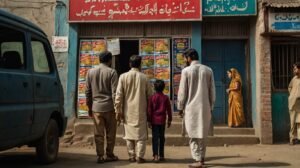
Introduction
Inflation is a term that has become increasingly familiar to people worldwide, particularly in the context of rising prices and the cost of living. In Pakistan, inflation has surged to alarming levels in recent years, profoundly impacting the daily lives of its citizens. From the price of food and fuel to housing and healthcare, inflation touches every aspect of life, creating challenges for families and individuals striving to maintain their standard of living.
In this article, we will explore the multifaceted effects of inflation on everyday life in Pakistan. We will discuss the underlying causes of inflation, its impact on various sectors, and the coping mechanisms individuals and families have adopted in response to rising prices. As we navigate these topics, our aim at **zaroraterishta.com** is to provide insightful analysis and practical advice for navigating the inflation challenges in Pakistan.

Section 1: Understanding Inflation
Definition of Inflation
Inflation is defined as the rate at which the general level of prices for goods and services rises, leading to a decrease in purchasing power. When inflation occurs, each unit of currency buys fewer goods and services than it did in previous periods. This phenomenon can be caused by various factors, including increased production costs, higher demand for goods and services, and changes in monetary policy.
Measuring Inflation
In Pakistan, inflation is measured using the Consumer Price Index (CPI), which tracks the prices of a basket of goods and services consumed by households. The CPI provides a reliable indicator of changes in the cost of living and is used by policymakers to gauge economic performance. A rising CPI indicates that prices are increasing, while a stable or declining CPI suggests that prices are stable or decreasing.
Historical Context of Inflation in Pakistan
Pakistan has experienced periods of high inflation throughout its history, often driven by economic instability, political challenges, and external factors. In recent years, inflation rates have surged due to various reasons, including fiscal deficits, currency devaluation, and supply chain disruptions. Understanding the historical context of inflation in Pakistan is essential for grasping its current implications.
For instance, during the 1970s, Pakistan faced hyperinflation, primarily due to government policies and external shocks such as the oil crisis. More recently, inflation spiked in the late 2000s and early 2010s, prompting government interventions and policy adjustments. These historical precedents set the stage for understanding today’s inflationary landscape.
The Importance of Inflation Awareness
Awareness of inflation and its effects is crucial for individuals and families as they navigate their financial futures. Understanding how inflation impacts purchasing power can lead to better financial decisions, such as investing in assets that may appreciate over time or taking steps to secure fixed-rate loans before rates climb higher.

Section 2: Causes of Inflation in Pakistan
1. Supply Chain Disruptions
One of the primary drivers of inflation in Pakistan is supply chain disruptions. Factors such as natural disasters, political instability, and global economic conditions can affect the availability of goods and services. For instance, the COVID-19 pandemic disrupted supply chains worldwide, leading to shortages of essential items and increased prices.
These disruptions have a cascading effect on prices. For example, if a natural disaster damages agricultural output, the reduced supply of food products can lead to higher prices in markets. Additionally, logistical challenges in transporting goods can exacerbate these issues, resulting in further price increases.
Case Study: The Impact of COVID-19
During the COVID-19 pandemic, Pakistan experienced significant disruptions in its supply chains. Lockdowns and restrictions on movement not only affected local production but also hindered imports. Consequently, essential goods became scarce, leading to price hikes. The pandemic underscored the fragility of supply chains and the direct impact on inflation.
2. Currency Devaluation
The devaluation of the Pakistani rupee against major currencies has contributed significantly to rising inflation. As the value of the rupee declines, the cost of imported goods increases, leading to higher prices for essential commodities. This situation puts additional pressure on consumers, especially those reliant on imported goods.
For instance, many everyday items, such as cooking oil and essential medicines, are imported. As the rupee weakens, the costs associated with these imports rise, directly impacting the prices consumers pay. This trend has been particularly evident in recent years, where fluctuations in currency value have resulted in erratic price changes.
3. Fiscal Deficits
Fiscal deficits, where government expenditures exceed revenues, can lead to inflationary pressures. When the government borrows excessively or prints more money to finance its deficits, it can increase the money supply, driving prices higher. Pakistan’s fiscal challenges have been exacerbated by political instability and economic mismanagement.
The impact of fiscal deficits is often felt most acutely by low- and middle-income families, as they are less able to absorb rising costs. As the government struggles to balance its budget, it may resort to measures that further inflate prices, creating a vicious cycle of economic stress.
4. Rising Global Commodity Prices
Global commodity prices, including oil and food, play a crucial role in influencing domestic inflation. As prices for essential commodities rise on the international market, consumers in Pakistan face higher prices for fuel, food, and other necessities. The recent surge in oil prices has had a particularly pronounced impact on transportation costs and, consequently, the prices of goods.
When global oil prices rise, the cost of transportation and logistics increases, which is then passed on to consumers in the form of higher prices for goods. This phenomenon can be seen in the prices of everyday items, from groceries to household supplies. Furthermore, fluctuations in agricultural commodity prices can affect food prices, leading to increased cost burdens on families.
5. Political Instability
Political instability can exacerbate inflation and economic uncertainty. Uncertainty regarding government policies and leadership can lead to a lack of investor confidence, affecting economic growth and stability. For instance, frequent changes in government or policy direction can create an unpredictable economic environment, leading to price volatility.
6. Demand-Pull Inflation
Demand-pull inflation occurs when the demand for goods and services exceeds their supply. In Pakistan, rising consumer demand, especially during festive seasons or after remittance inflows, can lead to higher prices. This type of inflation is often seen in markets with limited supply capacity, where producers struggle to meet demand.

Section 3: Impact of Inflation on Everyday Life
1. Rising Cost of Essentials
As inflation continues to rise, the cost of essential goods and services, including food, fuel, and healthcare, has escalated significantly. Families are finding it increasingly difficult to make ends meet as their purchasing power declines. Necessities that once seemed affordable are now straining household budgets.
Food Prices
Food inflation has been particularly pronounced in recent years. Staple items such as wheat, rice, and vegetables have experienced sharp price increases. According to reports, the price of wheat flour has surged, impacting the ability of families to purchase essential food items. Many households are forced to make difficult choices, such as reducing portion sizes or forgoing certain foods altogether.
For example, the price of potatoes, a staple vegetable, has seen a significant rise, leading many families to adjust their diets. Traditional dishes that once included a variety of vegetables are now simplified as families prioritize affordability over variety.
Fuel Costs
Rising fuel prices have also contributed to the overall increase in living costs. Higher transportation costs affect not only individuals who commute to work but also businesses that rely on transportation for goods and services. Consequently, the increased costs of transportation are passed on to consumers, further exacerbating inflationary pressures.
As fuel prices rise, many people are forced to reconsider their travel habits. Public transportation fares may increase, leading to higher commuting costs for workers. This situation can impact job choices, as individuals may limit their job search to areas closer to home to avoid high transportation expenses.
2. Impact on Housing and Rent
Inflation has also affected the housing market in Pakistan. Rising construction costs, driven by increased prices for materials, have led to higher housing prices and rental rates. Families seeking affordable housing are finding it challenging to secure suitable accommodations within their budgets.
Rent Increases
Many landlords are responding to rising costs by increasing rent prices. This situation places additional financial strain on tenants, particularly low- and middle-income families. The burden of rising rents often forces families to allocate a larger portion of their income to housing, leaving less for other essential expenses.
For instance, families may be forced to relocate to less desirable areas or smaller homes as they search for affordable housing. This trend can lead to increased stress and instability for families, particularly those with children who may have to change schools.
3. Healthcare Costs
Healthcare is another area where inflation has had a significant impact. Rising costs for medical supplies, treatments, and medications have made healthcare less accessible for many individuals and families. As prices rise, patients may delay seeking medical care or opt for cheaper alternatives, which can have long-term consequences for their health.
Prescription Medications
The cost of prescription medications has been particularly affected by inflation. Many individuals are finding it increasingly difficult to afford necessary medications, leading to concerns about health outcomes. The rising cost of healthcare can force families to make difficult choices between essential medications and other critical expenses.
For example, patients with chronic conditions may struggle to afford their medications, leading to worsened health outcomes. This situation highlights the importance of addressing healthcare costs as part of the broader conversation about inflation and its impact on quality of life.
4. Education and Access to Resources
Inflation also affects access to education and resources. Rising costs for school supplies, tuition fees, and extracurricular activities can strain family budgets. Parents may need to make sacrifices to ensure their children receive a quality education, which can have long-term implications for future generations.
School Fees
Many private schools have responded to rising costs by increasing tuition fees. This situation creates challenges for families seeking quality education for their children. As education becomes more expensive, some families may be forced to choose between quality education and affordability.
This trend can have lasting effects on children’s educational outcomes, particularly for those from low-income families. Access to quality education is a critical factor in breaking the cycle of poverty, and rising costs can exacerbate existing inequalities.
5. Quality of Life and Stress
The cumulative effects of inflation on daily life can lead to increased stress and anxiety for individuals and families. Concerns about financial stability, job security, and the ability to meet basic needs can take a toll on mental health and overall well-being.
Mental Health Impact
Financial stress is a significant contributor to mental health issues. As families struggle to cope with rising costs, the pressure can lead to anxiety, depression, and other mental health challenges. Recognizing the impact of inflation on mental health is essential for addressing the broader consequences of economic challenges.
Communities can play a vital role in providing support during challenging times. Mental health awareness initiatives can help individuals recognize the signs of stress and seek help when needed. Creating supportive environments can foster resilience and promote overall well-being.

Section 4: Coping Mechanisms and Strategies
1. Budgeting and Financial Planning
In response to rising inflation, many families are adopting more stringent budgeting and financial planning strategies. By tracking expenses and prioritizing needs over wants, individuals can better manage their finances in an inflationary environment.
Creating a Household Budget
Establishing a household budget can help families identify areas where they can cut back on spending. By categorizing expenses and setting limits, individuals can prioritize essential needs while reducing discretionary spending. This approach can provide a clearer picture of financial health and help families navigate challenging times.
Budgeting tools and apps can assist families in tracking their spending and setting financial goals. By involving all family members in the budgeting process, households can work together to make informed financial decisions.
2. Seeking Additional Income Sources
Many individuals are exploring additional income sources to offset the impact of inflation. This may involve taking on part-time work, freelancing, or starting small businesses. Diversifying income streams can provide a financial cushion during challenging economic times.
Side Hustles and Freelancing
Side hustles have become increasingly popular as individuals seek to supplement their incomes. Activities such as online tutoring, freelance writing, and home-based businesses have gained traction as people look for flexible ways to earn extra money. This approach allows families to adapt to rising costs while maintaining a work-life balance.
Additionally, local markets and community events can provide opportunities for artisans and small business owners to showcase their products. By tapping into local demand, individuals can create sustainable income streams that help alleviate financial pressures.
3. Community Support and Resource Sharing
Community support networks play a vital role in helping individuals and families cope with the effects of inflation. Local organizations and community groups often provide resources, food assistance, and support services to those in need.
Food Banks and Assistance Programs
Food banks and assistance programs are essential lifelines for families facing food insecurity due to rising prices. Many communities have established initiatives to provide nutritious food to those in need, ensuring that families can access essential resources during challenging times.
Community gardens and cooperative farming initiatives can also contribute to food security by providing fresh produce at lower costs. These collaborative efforts foster community bonds and encourage sustainable practices.
4. Educating Oneself on Financial Literacy
Increasing financial literacy is crucial for empowering individuals to make informed decisions about their finances. Understanding concepts such as budgeting, saving, and investing can help families build resilience in the face of inflation.
Workshops and Online Resources
Community organizations and educational institutions often offer workshops and online resources to enhance financial literacy. By providing individuals with the knowledge and skills necessary to manage their finances effectively, these initiatives can help families navigate economic challenges with confidence.
Promoting financial literacy in schools can also equip future generations with the skills they need to manage their finances responsibly. Early education on budgeting, saving, and investment can lay the foundation for sound financial habits.
5. Utilizing Technology for Financial Management
In today’s digital age, technology plays a pivotal role in financial management. Various apps and online platforms can help individuals track their expenses, set budgets, and manage investments more effectively.
Budgeting Apps and Tools
Numerous budgeting apps are available that can assist users in monitoring their spending habits. These tools allow individuals to set financial goals, categorize expenses, and receive alerts when they approach their budget limits. By leveraging technology, families can gain better control over their finances.

Section 5: Government Response and Policy Implications
1. Monetary Policy
The government and central bank play crucial roles in managing inflation through monetary policy. By adjusting interest rates and controlling the money supply, policymakers can influence economic conditions and stabilize prices.
Interest Rate Adjustments
In response to rising inflation, central banks may implement interest rate hikes to curb excessive spending and stabilize prices. Higher interest rates can discourage borrowing and spending, which can help bring inflation under control. However, this approach must be balanced to avoid stifling economic growth.
The effectiveness of monetary policy depends on various factors, including the overall economic environment and consumer confidence. Policymakers must consider the potential trade-offs between controlling inflation and supporting economic growth.
2. Fiscal Policy Measures
Fiscal policy measures, including government spending and taxation, also impact inflation and the cost of living. Policymakers must carefully consider how their decisions affect economic stability and the well-being of citizens.
Targeted Subsidies and Support Programs
Targeted subsidies for essential goods and services can help alleviate the burden of rising prices for low-income families. By providing financial assistance for food, fuel, and healthcare, the government can mitigate the impact of inflation on vulnerable populations.
Additionally, implementing social safety nets and welfare programs can provide crucial support for families facing economic hardship. These initiatives can help ensure that essential needs are met, even in times of rising inflation.
3. Promoting Economic Growth
Long-term solutions to inflation require a focus on promoting sustainable economic growth. By investing in infrastructure, supporting small businesses, and fostering innovation, policymakers can create an environment conducive to stability and prosperity.
Encouraging Investment and Job Creation
Government initiatives aimed at attracting investment and creating job opportunities can contribute to economic stability. By fostering a conducive environment for businesses to thrive, policymakers can help mitigate inflationary pressures and support long-term growth.
This focus on economic growth can also enhance overall living standards, providing individuals and families with greater financial security. Sustainable economic development is a crucial component of addressing the challenges posed by inflation.
4. Addressing Corruption and Mismanagement
Corruption and mismanagement can exacerbate inflationary pressures and hinder economic growth. Addressing these issues is vital for creating a stable economic environment. Policymakers must implement measures that promote transparency and accountability in government practices.
Strengthening Institutions
Strengthening institutions and governance frameworks can help reduce corruption and improve economic management. By fostering a culture of accountability, governments can create an environment that encourages investment and economic growth.

Section 6: The Path Forward
1. Building Resilience
As inflation continues to affect everyday life in Pakistan, building resilience becomes paramount. Individuals, families, and communities must adapt to changing economic conditions while prioritizing their well-being.
Community Engagement
Engaging with local communities can foster resilience and support networks. By coming together to share resources, knowledge, and experiences, individuals can navigate challenges more effectively. Community initiatives that promote collaboration and resource sharing can strengthen social bonds and enhance overall well-being.
2. Advocacy for Policy Change
Advocating for policy changes that address the root causes of inflation is essential for creating a more stable economic environment. Citizens can engage with policymakers to raise awareness about the challenges they face and push for solutions that benefit all.
Participating in Civic Engagement
Civic engagement, including voting and community involvement, empowers individuals to influence policy decisions. By advocating for economic reforms and social programs that support low-income families, citizens can contribute to positive change.
Participation in local governance and community organizations can provide individuals with a platform to voice their concerns and advocate for policies that address inflation and its effects.
3. Fostering Financial Literacy
Encouraging financial literacy at all levels of society can help individuals make informed decisions about their finances. Educational initiatives that focus on budgeting, saving, and investing can empower families to navigate inflation with greater confidence.
Collaborative Efforts
Collaboration between the government, educational institutions, and community organizations can enhance financial literacy initiatives. By working together, stakeholders can develop comprehensive programs that equip individuals with the skills needed to thrive in an inflationary environment.
Promoting financial literacy in schools can help instill responsible financial habits in future generations, creating a more financially savvy population.
4. Embracing Technological Innovations
As technology continues to evolve, embracing innovative solutions can help mitigate the effects of inflation. From digital payment systems to e-commerce platforms, technology can enhance efficiency and reduce costs.
E-Commerce and Online Marketplaces
The rise of e-commerce and online marketplaces has transformed how consumers shop. By providing access to a wider range of products at competitive prices, these platforms can help consumers save money and make informed purchasing decisions.
5. Supporting Local Economies
Supporting local businesses and economies can benefit communities and help mitigate inflationary pressures. When individuals choose to shop locally, they contribute to the economic health of their communities and support job creation.
Community Initiatives
Community initiatives that promote local products and services can enhance economic resilience. Farmers’ markets, local craft fairs, and small business expos can encourage residents to support their local economies while fostering a sense of community.

Conclusion
Inflation is a complex and multifaceted issue that affects everyday life in Pakistan. As rising prices challenge families and individuals, understanding the causes and consequences of inflation is essential for navigating these turbulent times. By adopting coping mechanisms, advocating for policy changes, and fostering financial literacy, individuals can build resilience and empower themselves in the face of economic challenges.
At **zaroraterishta.com**, we aim to provide valuable insights and resources to help our readers navigate the complexities of inflation and its impact on daily life. By staying informed and engaged, we can collectively address the challenges posed by inflation and work towards a more stable and prosperous future.
10 Detailed FAQs for the Article
-
What is inflation, and how is it measured in Pakistan?
Inflation refers to the general rise in prices over time, leading to a decline in purchasing power. In Pakistan, it is measured using the Consumer Price Index (CPI), which tracks changes in the price of essential goods and services. -
What are the main causes of inflation in Pakistan?
Key drivers include currency devaluation, supply chain disruptions, rising global commodity prices, fiscal deficits, political instability, and demand-pull inflation from increased consumer spending. -
How does inflation impact the daily lives of Pakistani citizens?
It increases the cost of essential items like food, fuel, rent, healthcare, and education, forcing families to cut back on spending, reduce consumption, or seek additional income. -
Which sectors in Pakistan are most affected by inflation?
The food and agriculture sector, fuel and transportation, housing and real estate, healthcare, and private education are the most impacted, affecting both middle and low-income families. -
What coping strategies are Pakistani families using to deal with inflation?
Common strategies include strict budgeting, seeking part-time or freelance work, community food-sharing, using budgeting apps, and relying on support networks or NGOs. -
How has the government responded to inflation in Pakistan?
The government has implemented monetary policies (like interest rate adjustments), subsidies on essential items, and social support programs. However, their effectiveness remains debated. -
What long-term solutions could help reduce inflation in Pakistan?
Investing in local production, improving governance, reducing dependency on imports, boosting exports, strengthening institutions, and implementing economic reforms could help control inflation sustainably. -
How does inflation affect mental health and overall quality of life?
Financial pressure caused by inflation can lead to stress, anxiety, and depression. Families face difficult decisions about food, healthcare, and education, impacting emotional well-being. -
Are there any benefits to inflation?
Mild inflation can encourage spending and investment. However, when inflation becomes too high, especially in developing countries like Pakistan, the negative impacts usually outweigh the positives. -
What role does financial literacy play in combating inflation?
Financial literacy helps individuals understand budgeting, saving, and investing—critical tools to maintain stability and resilience in inflationary environments.
